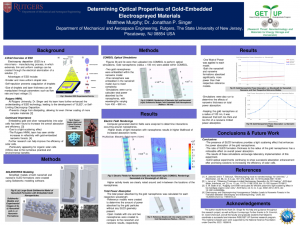Murphy, Matthew: Determining Optical Properties of Gold-Embedded Electrosprayed Materials
Title: Determining Optical Properties of Gold-Embedded Electrosprayed Materials
Name: Matthew Murphy
Home Institute: The College of New Jersey
Programs: RISE program, REU – Green Energy Technology Undergraduate Program (GET UP)
Other contributors: Jonathan P. Singer
Abstract: In electrospray deposition (ESD), an electrical field is used to atomize monodisperse micro- and nano-sized droplets, which are deposited on a substrate with high efficiency. Through research conducted by Professor Jonathan P. Singer and his team at the Rutgers University Hybrid Micro-/Nano-manufacturing Laboratory (HMNL), further investigations have been made into ESD. Specifically, they have investigated how the varying of numerous experimental parameters (such as flow rate, input voltage, and solution concentration) affect the self-limiting electrospray deposition (SLED) regime of ESD. This spray regime creates conformal polymeric nanoparticle and nanoshell morphologies on the target substrate.
The Rutgers HMNL team has begun to incorporate additives, such as silica and gold nanoparticles, into these coatings. Optical measurements have shown that embedded nanoparticles remain isolated while entrapped in the polymer structures. This project’s objective is to simulate a SLED structure with embedded gold nanoparticles and to analyze the power absorbed by the nanospheres when exposed to a light wave, as well as gather more information on the optimization of the size and loading of the polymer and gold nanoparticles.
Solidworks models of both polymer nanoshell and nanowire geometries were created based on laboratory results from previous experiments. These models were then uploaded into COMSOL, where gold nanospheres of 100 nm radii were embedded. After running simulations of varying wavelengths, it was found that the presence of the SLED geometries enhanced the amount of power absorbed by the gold nanoparticles, when compared to reference models that contained just the nanospheres. Simulations were also run to show that too small or too great of a SLED particle size limits the potential absorbance of the nanospheres.
The results obtained from these simulations could inspire further research into functional nanoparticle-embedded SLED assemblies and the potential applications that this innovative technology can add to the green energy field.
Biography: Matthew Murphy is currently a rising senior at The College of New Jersey studying Mechanical Engineering. He has spent his entire life living in South Jersey, and graduated from Delran High School in 2017. In his collegiate academic career, he has had the honor of receiving numerous private and school-funded scholarships, as well as multiple awards and recognitions. He has twice received the Fred O. Armstrong Scholar Award, placing him at the top of his academic class; been inducted into Tau Beta Pi Engineering Honors Fraternity and Phi Kappa Phi Interdisciplinary Honors Society; as well as been recognized for achieving Dean’s Lists for six semesters. He intends to pursue a graduate degree in the field of engineering, and has particular interests in green energy as well as materials science, both of which are main reasons why he was drawn so strongly towards the GETUP program. Matthew believes that these fields are pivotal to our society and can make a true difference in impacting our world for the better!
